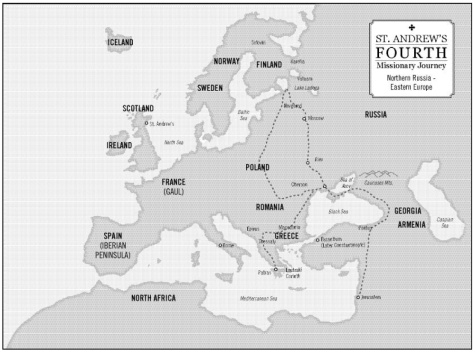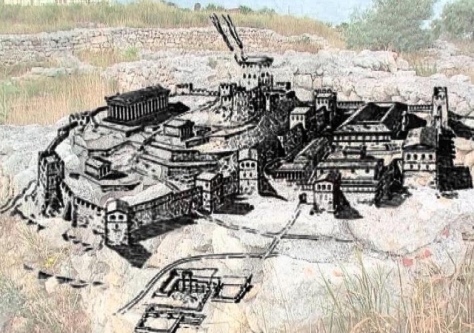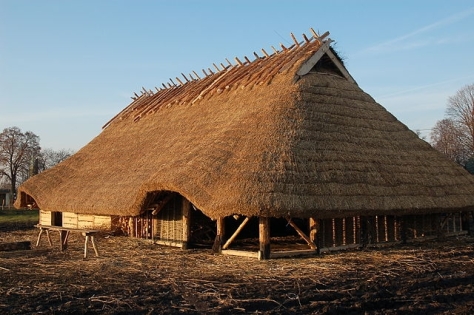Part One: Seas Red and Black
Part Two: Riders Beyond the Silk Road
Part Three: In The Country of the Man-Eaters
Saint Andrew is the patron saint of several countries: Scotland, of course, but he's also the patron saint of Barbados, Cyprus, Georgia, Greece, Romania, Russia, Sicily, Ukraine, and the medieval Kingdom of Prussia. Would it surprise you to learn that there is a possibility he has visited most of them?
Andrew has already been to Cyprus and Georgia on previous journeys, and many of the locations in Anatolia he visited had significant Greek populations. Following the Dormition of the Mother of God, Andrew commenced his fourth and final great missionary journey.
To start with, Andrew went back to familiar lands: to Pontus, Georgia, and the Caucasus. Where once he went east, this time, he chose north - to the Sea of Azov, which lies between Ukraine, Russia, and the Crimean Peninsula.
During the time of Andrew, the Kingdom of the Cimmerian Bosporus, which became another client kingdom of the Roman Empire a century earlier, controlled Crimea and the western shores of the Sea of Azov. The Bosporan Kingdom was the grand culmination of centuries of Greek colonisation mixing with the indigenous Cimmerians: the cities of Panticapaeum (modern Kerch), Nymphaeum, Myrmekion, and Phanagoria soon joined together to stave off raids from the mighty Scythians (there they are again!) and became a formidable force over time.
The Bosporans fused the seemingly incompatible traditions of the nomadic horsemen of Scythia with the settled civilization of the Hellenes: it was so successful, the Bosporan Kingdom was the longest-lasting of all the Roman client-kingdoms, retaining its culture until 370 AD, when it was one of the first fringes of the Empire to feel the wrath of the Huns. The Bosporans exported fish, wheat, and slaves, and their treasures are still being found in their burial kurgans.
Andrew would undoubtedly have friends in the Bosporan Kingdom, which had early Christian communities in Sebastopol and Cherson. But he did not stay forever, and so he resumed his journey, following the Dnepr River - and far beyond the borders of classical civilisation. The lands Andrew now traveled - what is now Ukraine - were the realm of the Sarmatians.
The Sarmatians were a confederation of nomadic tribes not unlike their Scythian neighbours. For centuries, they lived in relative peace, but three centuries before Andrew, the Sarmatians embarked on a vicious campaign of conquest: by the time Andrew came among them, they ruled vast swathes of the European Steppes. That the warlike tribes of Alans, Roxolani, Iazyges, Aorsi and Siraces stayed together at all was likely a result of canny leadership and political expediency.
Sarmatian warriors were every bit as fearsome, clad in thick padded trousers & coats, with long hair and beards, deadly horse archers like their Scythian neighbours - and, just like the Scythians, they boasted women warriors. However, the true terror of any Sarmatian army was in their heavy cavalry: both rider and mount were covered in scale armour almost head to toe, with a distinctive helmet, and bearing a great two-handed lance. These powerful horsemen left a great impression on the Romans, Sassanids, and Germanic tribes, who either hired them for their own campaigns, or copied them. The legendary Cataphracts of the Byzantine Empire, the Paladins of Charlemagne, and the knights of early Christendom all owe a debt to the famous Sarmatian Lancers.
In addition to the Scottish connection of the Scythians, the Sarmatians have connections to the British Isles of their own: in the 2nd Century, a colony of Sarmatian veterans were stationed in Bremetennacum - what is now Lancashire. C. Scott Littleton and Ann C. Thomas suggest this, as well as parallels between the Sarmatian legend of Batradz, may have been possible inspiration for aspects of Arthurian Legend.
Information on Sarmatian religion is rather scarce. One of the few certainties is that they worshipped a war god, who was represented by a sword thrust into the ground, with sacrificial offerings of blood. His name was prohibited from being spoken aloud. Greek sources from the 3rd Century BC also claim the Sarmatians worshipped fire and the sun: there is evidence of this in Sarmatian funerary rites, and both were venerated by the later Alans and Ossetians.
Andrew continued up the Dnieper to the lands beyond even the Sarmatians, where there were no kingdoms, confederacies, or empires - just a great wilderness populated by tribes. There are fairly advanced archaeological finds from the swamps and forests of Prippet and the upper Dnieper basin, such as iron tools and weapons. Herodotus mentioned the Budini as dwelling beyond the Sarmatians. It is possible that these people were the ancestors of the Slavs:
The Budini are a great and numerous nation; the eyes of all of them are very bright, and they are ruddy. They have a city built of wood, called Gelonus. The wall of it is thirty furlongs in length on each side of the city; this wall is high and all of wood; and their houses are wooden, and their temples; for there are among them temples of Greek gods, furnished in Greek fashion with images and altars and shrines of wood; and they honour Dionysus every two years with festivals and revels. For the Geloni are by their origin Greeks, who left their trading ports to settle among the Budini; and they speak a language half Greek and half Scythian. But the Budini speak not the same language as the Geloni, nor is their manner of life the same.Herodotus wrote of Androphagi dwelling in this region, and, chillingly, human bones with human teeth marks have been found in excavations. Andrew just couldn't seem to get away from cannibals, could he?
The Budini are native to the soil; they are nomads, and the only people in these parts that eat fir-cones; the Geloni are tillers of the soil, eating grain and possessing gardens; they are wholly unlike the Budini in form and in complexion. Yet the Greeks call the Budini too Geloni; but this is wrong. All their country is thickly wooded with every kind of tree; in the depth of the forests there is a great and wide lake and marsh surrounded by reeds; otters are caught in it, and beavers, besides certain square-faced creatures whose skins serve for the trimming of mantles, and their testicles are used by the people to heal sicknesses of the womb.
- Herodotus, History of Herodotus
Also in this wilderness dwell the Neuri, who, if anything, are even more mysterious:
The Neurian customs are like the Scythian. One generation before the attack of Darius they were driven from their land by a huge multitude of serpents which invaded them. Of these some were produced in their own country, while others, and those by far the greater number, came in from the deserts on the north. Suffering grievously beneath this scourge, they quitted their homes, and took refuge with the Budini. It seems that these people are conjurers: for both the Scythians and the Greeks who dwell in Scythia say that every Neurian once a year becomes a wolf for a few days, at the end of which time he is restored to his proper shape. Not that I believe this, but they constantly affirm it to be true, and are even ready to back their assertion with an oath. - Herodotus, The Persian Wars
Good grief, first cannibals, now werewolves!?
Herodotus suggests that the lands beyond the Budini and Neuri were uninhabited: however, there is evidence of human habitation - and St. Andrew's presence - even to the very coast of the Baltic Sea. Examples of Greek and Roman coins have been found in the Baltic area, the final stop on the Amber Road. The people of this area were called Aesti, "Easterners" - the geographical ancestors of the Estonians.
Turning, therefore, to the right hand shore of the Suebian sea, we find it washing the country of the Aestii, who have the same customs and fashions as the Suebi, but a language more like the British. They worship the Mother of the Gods, and wear, as an emblem of this cult, the device of a wild boar, which stands them in stead of armor or human protection and gives the worshipper a sense of security even among his enemies. They seldom use weapons of iron, but clubs very often. They cultivate grain and other crops with a perseverance unusual among the indolent Germans. They also ransack the sea. They are the only people who collect amber - glaesum is their own word for it - in the shallows or even on the beach. Like true barbarians, they have never asked or discovered what it is or how it is made.
For a long time, indeed, it lay unheeded like any other refuse of the sea, until Roman luxury made its reputation. They have no use for it themselves. They gather it crude, pass it on in unworked lumps, and are astounded at the price it fetches.
- Tacitus (an old friend of the blog), Germania
The Amber Road was a comparatively bustling and popular trade route, reaching from the Dnieper delta to Lake Ladoga. There is a local tradition in the area that Andrew even went to the Solovki islands - possibly inspired by the discovery of ancient coins bearing his image.
Having taken his cross to the icy north, Andrew began to turn around. He turned westwards into what is now Poland - and what was then the country of the Gothones.
Beyond the Lygians dwell the Gothones, under the rule of a King; and thence held in subjection somewhat stricter than the other German nations, yet not so strict as to extinguish all their liberty. Immediately adjoining are the Rugians and Lemovians upon the coast of the ocean, and of these several nations the characteristics are a round shield, a short sword and kingly government. Next occur the communities of the Suiones, situated in the ocean itself; and besides their strength in men and arms, very powerful at sea. The form of their vessels varies thus far from ours, that they have prows at each end, so as to be always ready to row to shore without turning nor are they moved by sails, nor on their sides have benches of oars placed, but the rowers ply here and there in all parts of the ship alike, as in some rivers is done, and change their oars from place to place, just as they shift their course hither or thither.
To wealth also, amongst them, great veneration is paid, and thence a single ruler governs them, without all restriction of power, and exacting unlimited obedience. Neither here, as amongst other nations of Germany, are arms used indifferently by all, but shut up and warded under the care of a particular keeper, who in truth too is always a slave: since from all sudden invasions and attacks from their foes, the ocean protects them: besides that armed bands, when they are not employed, grow easily debauched and tumultuous. The truth is, it suits not the interest of an arbitrary Prince, to trust the care and power of arms either with a nobleman or with a freeman, or indeed with any man above the condition of a slave.
- Tacitus, Geographica
The Goths of Andrew's time were understandably very different from the hordes which conquered Rome: the Wielbark culture, which replaced the Oksyqie culture, appeared around the same time as Andrew's last journey, and is traditionally linked to the migration of the Goths from Scandinavia from Jordanes' account onward. The Wielbark people worked in bronze to make their ornaments: silver, gold, and iron was rare. They cremated and buried their dead without weapons or tools, but sometimes with clay vessels, accessories, and even spurs. Like many cultures of northern Europe, the Wielbark built stone circles, stone covered mounds, and standing stones.
So, after travelling around the Black Sea, through the Strait of Kerch onto the Sea of Azov, up the Dnieper River to the frozen north, Andrew really did travel to the ends of the earth. But rather than simply follow the same route back, he travelled a different route - and it's on this route home that some of his most astonishing, spectacular, and bizarre adventures occurred.
Andrew still had far to go before his final journey's end...
Part Five: The Outermost Ends of the Earth
Part Six: A Cave in the Realm of the Wolf-People
Part Seven: "This Day A Martyr Or A Conqueror!"
Part Eight: Martyrdom in the Land of Lost Gods
Part Nine: The Scotland Yet To Come






No comments:
Post a Comment